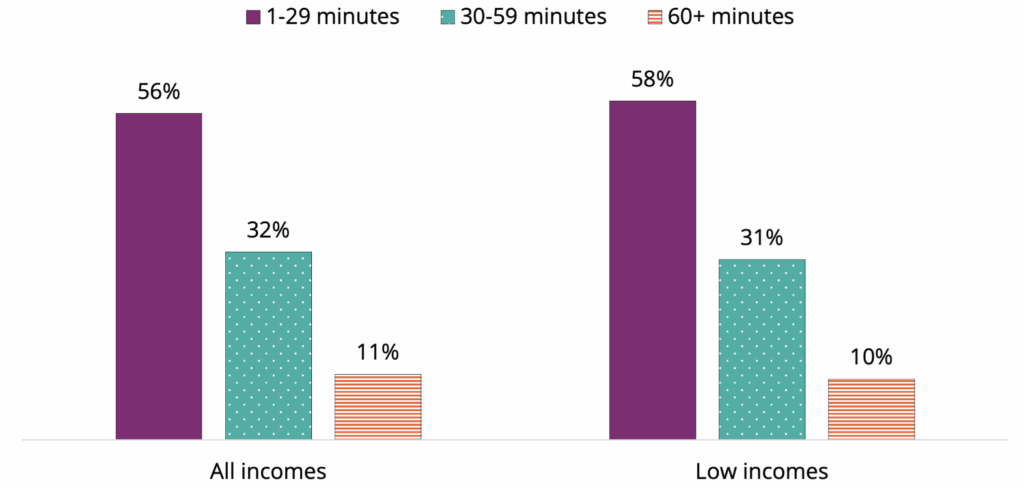Nov 12, 2025
Data Point, Hispanic Child and Family Facts, Research Publication
One in 10 Hispanic Parents With Low Incomes Commute an Hour or More
Authors:
Most employed Hispanic parents with low incomes (defined as those with family incomes below 200% of the federal poverty threshold, or FPL) commute to work; only 6 percent work from home (Table A). For those who work outside the home,1 the average time needed to travel to work is 27.8 minutes (Table B). However, many working Hispanic parents with low incomes spend substantially more time than this on their commutes.
One in 10 (10%) Hispanic parents with low incomes who commute travel 60 minutes or more, according to our new analysis of 2023 American Community Survey and Puerto Rican Community Survey data. Nearly one third (31%) have a commute of 30 to 59 minutes and more than half (58%) have a commute of less than 30 minutes. Commute times are nearly identical among all Hispanic parents regardless of their income, as seen in Figure 1.
Figure 1. One in 10 working Hispanic parents in families with low incomes have a one-way commute of 1 hour or more
Travel-to-work time among working Hispanic parents, by family income, 2023
 Source: Authors’ analysis of the Census Bureau’s 2023 American Community Survey and Puerto Rican Community Survey 1-Year data obtained via IPUMS USA, University of Minnesota, www.ipums.org.
Source: Authors’ analysis of the Census Bureau’s 2023 American Community Survey and Puerto Rican Community Survey 1-Year data obtained via IPUMS USA, University of Minnesota, www.ipums.org.Notes: Sample includes Hispanic parents with at least one child under age 18 living in the household, who worked outside the home the previous week, who are not living in group quarters, and for whom data on poverty status and commute time were not missing. “Low incomes” are family incomes below 200% of the federal poverty threshold.
Working Hispanic parents with low incomes born outside of the United States are less likely than those born in the United States to work from home (4% vs. 7%; see Table A). Those who work outside the home also face longer commutes than their U.S.-born counterparts. Twelve percent of working Hispanic parents with low incomes born outside of the United States have a one-way commute of 60 minutes or more, compared to 9 percent of those born in the United States.
As detailed above, commute times can be quite substantial for many working Hispanic parents with low incomes and can limit the amount of time each day that they are able to spend with their families—for example, by eating meals together. Long commutes can also be costly, whether these costs are related to owning and maintaining a vehicle or to covering the costs of other forms of transportation, including public transportation. Research finds that commuting costs effectively reduce workers’ take-home wages, particularly among workers with lower incomes, and may discourage employment.
For many parents, particularly working mothers, commute times are longer because they also include time spent taking children to child care or to school. This additional time can be quite substantial for families with young children who live in communities with limited access to affordable, high-quality care (i.e., child care deserts), who therefore must travel further to find care. Child care challenges may be particularly acute for families who work nonstandard hours and need child care in the early morning, during the evenings, or on the weekend.
In some states, human service programs account for families’ commute time in the provision of benefits. For example, under the Child Care and Development Fund (CCDF), states have flexibility in determining the number of reimbursable hours for child care for which a family is eligible, and some include commute time between work (or education/training) and child care. In fact, a recent analysis carried out by Center investigators found that three quarters (12) of the 16 states with the largest Hispanic populations include commuting (and/or meals and breaks) in the time approved for child care subsidy coverage; however, there is quite a bit of variability in the amount of commute time covered across states. States can also use Temporary Assistance for Needy Families funds to help overcome other transportation-related barriers to employment by reimbursing automobile-related costs (e.g., gas, mileage, auto repairs), providing financial assistance to purchase a car, or issuing vouchers for public transit.
Methods
For this analysis, we used data from the U.S. Census Bureau’s 2023 nationally representative American Community Survey (ACS) and Puerto Rican Community Survey (PRCS) 1-year samples, obtained from IPUMS USA. We define Hispanic parents as individuals who report being of Latino, Hispanic, or Spanish origin, regardless of their race, and who report having at least one child of their own under age 18 living in their household. Our estimates of working from home (Table A) come from an analytic sample of 83,672 Hispanic parents ages 16 or older (the population included in employment questions) who were not living in group quarters, for whom data on poverty status were not missing, and who were employed and reported working in the previous week. For our commute time analysis, we further restrict this sample to the roughly 90 percent who worked outside the home (consistent with the approach taken by the Census Bureau) and who provided travel-to-work time information, resulting in 74,924 Hispanic parents (Figure 1 and Table B).
The ACS and PRCS employment questions are asked of all household members ages 16 and older. For those who report being employed and working, questionnaires ask respondents about their travel to work, including their typical total travel time in minutes from home to work based on the previous week. Respondents who worked from home, who are excluded from the commute time analysis, have a value of 0 for their travel time, so the possible travel times for those who worked outside of the home start at 1 minute. In the 2023 data, reported travel-to-work time values go up to 179 minutes (just under 3 hours). For this analysis, we looked at the average travel-to-work time as well as the distribution across three categories: 1 to 29 minutes, 30 to 59 minutes, and 60 minutes or longer.
We created the category of families with low incomes using the IPUMS-constructed poverty variable, which calculates each person’s family income as a percentage of their family’s poverty threshold (see this summary of the poverty measure in IPUMS). We also show estimates according to whether parents were born in or outside of the United States.
We used survey-adjusted global Chi-square tests and Wald t-tests to assess differences by nativity for working from home and for the three commute time ranges; we used survey-adjusted ordinary least squares regression for average commute time (on the original variable as well as the log average commute time, as a sensitivity check since the values are skewed right).
Table A. Percentage of Hispanic parents who have a child under age 18 in the household and who worked from home in the previous week (i.e., they had no commute to work), by family income and whether they were born in the United States
 Source: Authors’ analysis of the Census Bureau’s 2023 American Community Survey and Puerto Rican Community Survey 1-Year data obtained via IPUMS USA, University of Minnesota, www.ipums.org.
Source: Authors’ analysis of the Census Bureau’s 2023 American Community Survey and Puerto Rican Community Survey 1-Year data obtained via IPUMS USA, University of Minnesota, www.ipums.org.Notes: Sample includes Hispanic parents with at least one child under age 18 living in the household, who reported being employed and at work in the previous week, who are not living in group quarters, and for whom data on poverty status are available. “Low incomes” are family incomes below 200% of the federal poverty threshold.
a Differences by parental country of birth are statistically significant at p<0.001.
Table B. Travel-to-work time among Hispanic parents who have a child under age 18 in the household and who worked outside the home in the previous week, by family income and whether they were born in the United States
 Source: Authors’ analysis of the Census Bureau’s 2023 American Community Survey and Puerto Rican Community Survey 1-Year data obtained via IPUMS USA, University of Minnesota, www.ipums.org.
Source: Authors’ analysis of the Census Bureau’s 2023 American Community Survey and Puerto Rican Community Survey 1-Year data obtained via IPUMS USA, University of Minnesota, www.ipums.org.Notes: Sample includes Hispanic parents with at least one child under age 18 living in the household, who reported being employed and working outside the house in the previous week, who are not living in group quarters, and for whom data on poverty status are available. “Low incomes” are family incomes below 200% of the federal poverty threshold.
a Differences by parental country of birth are statistically significant at p<0.001.
Suggested citation
Wildsmith, E., & Alvira-Hammond, M. (2025). One in 10 Hispanic parents with low incomes commute an hour or more. National Research Center on Hispanic Children & Families. https://doi.org/10.59377/701q5032o
1 Consistent with the approach taken by the Census Bureau, commute times are only calculated for respondents who report working outside of the home.




